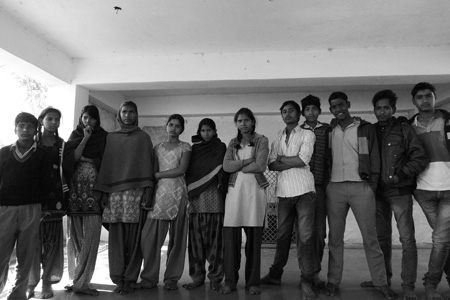Creative Education in Rajsamand
The train from Jaipur to Mavli - a small railway town between Udaipur and Rajsamand - took six hours, 2nd class a/c curtained comfort all the way. I was travelling to the Anuvibha Children's Peace Palace at Rajsamand, where I would be staying for five weeks or so, and from where under the charitable umbrella of The Create Trust (a UK registered charity I founded n 2006) I would run a series of creative education projects with local children and teacher training workshops in partnership with Anuvibha.
The project would use visual and performing arts; drawing, painting, building, designing, colouring, miming, acting and beautifying the environment, plus discussion and debate. The aims of the scheme where to stimulate creative thinking; strengthen self-confidence; encourage self-awareness; build a sense of social responsibility; provide an environment for creative play and establish a platform for discussion of social issues which concern the children. Anuvibha kindly supplied all the materials for the work, including pencils, paper, crayons, pens, paints, card, more pencils, more paper, more paint and brushes. All that was required to support a rich diverse series of art based workshops.
Together with a volunteer from Britain and local co-workers, who served as translators and workshop volunteers we worked with three local schools, two government run institutions and one private primary school for varying periods of time. Despite India recording economic growth of 9% for the past twenty years government schools lack the basics of classroom desks and chairs (children sit on mats on the floor), books, pictures or colour on the walls. The primary project though was in a village 15 kilometers outside of Rajsamand named Amloi. We conducted six, sometimes seven workshops a week here for four weeks.
Amloi
A small village of approximately 200 families over half of whom are living in extreme poverty, Amloi lacks basic sanitation - meaning the homes do not have toilets or mains water supply.
The work in the village begun after a visit with Sanchay Jain during which time we spoke to some of the families and a group of teenage children, explained the nature of the project and agreed a timetable. We would conduct workshops every day after 4.30 pm when the children returned home after school.
The work began Monday with thirty or so children aged from three to 17 years, and every day the numbers seemed to grow. In the end it settled at around fifty. We had agreed to form two groups and to alternate the days - younger ones one day, older children the next, but in keeping with Indian systems of order, all the younger children turned up every day, and on many days, so did the teenagers. Seen through unprepared eyes the sessions often appeared to be chaotic, with paper, pencils colour, paint and children swimming together in a sea of spontaneity and let me add, happiness. It was I remarked to a friend in London, like watching water, pure and alive, flow down the Himalayan mountains: uncontrollable beauty and bubbling joy.
They coloured elephants and angels, horses and giraffes, made masks from newspaper and waste cardboard, drew life size body drawings, acted their lives, invented comic strip characters and wrote stories featuring their inventions. Stories later compiled into books, which would become the first in the catalogue of the new Amloi children’s library - one of the key schemes to flow from the project. The library - of humble beginnings, consists of a single bookcase housed in the home of some of the children. Anuvibha have agreed to donate a selection of children’s books to line the bookshelves and collections of English language children books will soon join them. The beautification of the environment was a part of the project, and to this end the older children designed modern murals consisting of pure colour for the external walls of the temple. Modrian’esque blocks of red, yellow, blue and white where applied by the group to a strip of flaking paint, invigorating the building and drawing the attention and praise of the whole community.
A contemplation spiral was installed between the main temple and outside temple. Made from collected rocks painted in the same colours, the spiral will function as a place for reflection and healing, a peaceful space where worries can be left and peace discovered - well that's the hope anyway. Long term I hope the spiral will be a centerpiece for a communal garden, to include a children’s play area.
Building hope
What future awaits the children, 11 year old Maya for example, whose father is ill, and along with her mother works on building sites for the degrading, virtually unlivable wage of 250 - 300 rupees a day (US $ 3 - 3.50). Will she too be condemned to a life of servitude and hardship, is she looking at thirty years working as a maid of carrying piles of bricks on her head as her Mother does, or working on road works hauling a shovel.
The four-week project in Amloi was an integrated pilot project. We conducted a series of discussions with children and parents to assess what their needs are, both immediate and long-term. These community talks will serve as the basis for a long-term project, consisting of three key components: children, community and environment. A variety of education schemes will form the basis of the work with the children, including IT skills, vocational training, English language classes and continuing the creative education project to encourage independent thinking, initiative and building self-confidence/belief.
We have established a close relationship with the people of Amloi and are committed to providing any support we can. The first priority is to build a public toilet for the community, to pressurize the local government to meet their constitutional duty and provide mains water and street lighting. Long-term we are determined to offer the necessary educational support for Maya and her friends, to create hope of something better and provide the possibility of a more fulfilling dignified life for children and their parents.
Graham Peebles
London February 2014
Director
The Create Trust
Photos:

Graham Peebles amaong the youngsters

Vinita and the little ones

Maya painting the temple walls

Sonya colouring

Shoes

Teenage group Amloi
 Graham Peebles
Graham Peebles